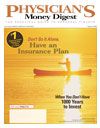Publication
Article
When You Don't Have 1000 Years to Invest
Author(s):
Investment advisors talk about the long run becausemarkets are variable. We don't have nearly enough long-termdata, and at best, short-term data is mere noise in a veryturbulent process. We have only very crude approximationsfor risk premiums, and in fact, they may change over time.So we look at what pitiful little data we have and try to makereasonable judgments about what the long-term performancemight be. Given 1000 years, we think we have a tolerablyclose approximation of what returns might look like.We freely admit we don't have a clue about what the next 12or 24 months might look like. Investing is about risk andrisk management. Elegant theory collides with real-lifeevents. It's a very messy process.
BusinessWeek
It turns out that the long run can be a very long time. Forinstance, in the 1970s and 1980s there was a 19-year periodduring which Treasury Bills outperformed the S&P 500.Even threw in the towel, proclaiming "TheDeath of Equities" boldly across their front page. This capitulationby the voice of capitalism almost exactly marked thebeginning of the longest, strongest bull market in history. Somuch for expert opinion.
Unfortunately, investors talk and think about the shortrun because their horizons are limited. Their first response toa discussion about long-term results is likely to be, "I don'thave 1000 years." They have every right to think that way.After all, this is their life, they only get one shot at it, and a2-or 3-year market downturn might seem like an eternity,especially if it starts right after they retire. Few of them havethe patience to wait 1000 years for things to work themselvesout to approximate the averages. Retirees are particularlysensitive to this issue because they typically needincome now.
The Retiring Investor's Dilemma
While retirees may not have 1000 years, they may verywell need to plan for 40 years. With inflation ever present,fixed income or guaranteed accounts will simply not do thejob. If we think only short term, and if we don't provide foradequate growth, we risk a catastrophic loss of buying power.
The investor has a real dilemma. On one hand, almost allinvestors need the higher returns and inflation protectionthat only equity investments provide. On the other hand,risk premiums (ie, expected returns) do not reliably showup each and every year as theory predicts that they shouldover the long haul. In fact, the predictedrisk premiums may not show up fora very long time. A few bad years earlyin retirement and the retiree could liquidatetheir entire nest egg.
So, we must have a strategy that providesfor some growth and at the sametime will withstand market downturns.The Great Depression, 1973-1974, thecrash of 1987, the crash of 1989, andthe horrible slump of 2000-2002 wereall real events that destroyed the financialsecurity of millions. No one shouldwant to place themselves at risk for that.
Given that returns are random andtotally unpredictable in the short term,what's an investor to do? Without theability to predict the future, howshould the investor construct theirportfolio to meet their unique requirementsof safety, income, and growth?
There is an approach that maximizesthe probability of long-term successand provides protection againstshort-term market loss. In other words,the investor need not give up hope ofsome long-term growth of principaland income in order to hedge againstshort-term market uncertainty. Withinreasonably defined limits, the investorcan have their cake and eat it too.
Finding the Perfect Balance
As a first cut, the investor must segregatetheir nest egg into two parts.The first part should be enough to satisfyall of their income needs for atleast 5 to 7 years—preferably 10. Thatpart must be invested in a rock-solid,safe instrument such as high-qualityshort-term bonds. This portion of thefund hedges against those nasty occasionalmarket downturns of unknowncause and unknowable duration.
The remaining part of the portfolioshould be in a globally diversified portfolioof equities to provide for the realreturn and growth necessary to meetthe investor's objectives. Particularcare must be taken to achieve an equityportfolio with the lowest possiblerisk as measured by annual fluctuationor standard deviation. This is bestaccomplished by wide diversificationof asset classes.
Having sufficient funds holed awayin rock-solid, highly liquid investmentsallows the investor to weather thestorms that must certainly come. Theinvestor should never be faced with havingto liquidate any of the volatile equityinvestments at inopportune times.
We can back test this approach, atleast back to 1926, to determinewhether it would have survived anypast market conditions. Monte Carloanalysis gives us another useful tool tostress test our assumptions. Neithertechnique is perfect, but we can get avery good feel for a "range of reasonableness." While there is never a guaranteein the markets, this technique hasstood the test of time.
Assuming sustainable withdrawalrates, appropriate asset allocation, andreasonable portfolio costs, this approachoffers the best probability ofsuccess over the long haul, while meetingthe investor's needs for short-termprotection against down markets.
Frank Armstrong III, CFP®, AIF, is the founderand principal of Investor Solutions, Inc, afee-only, SEC-registered investment advisor.He is also the author of The InformedInvestor: A Hype-Free Guide to Constructinga Sound Financial Portfolio (Amacom; 2002), which is nowavailable in paperback. For more information, visitwww.investorsolutions.com.
